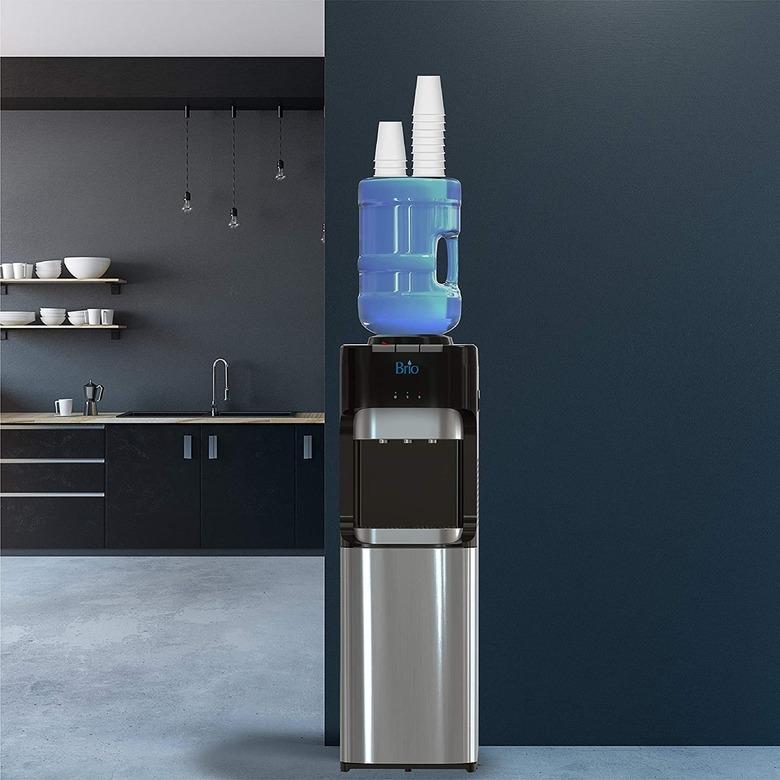How To Clean A 5-Gallon Water Cooler
Having cool, filtered water available at any time with the press of a button or flick of a lever is one of life's little luxuries. But having a water dispenser also comes with a few responsibilities. Not only do you need to know how to safely change the water cooler bottle when it's empty but you should also know how to clean the dispenser to keep germs and mineral deposits from building up. If you reuse and refill your own bottles, you might also have to know how to clean water dispenser bottles themselves.
Here's what you need to know about how — and how often — to clean a 5-gallon water cooler bottle and a water dispenser.
How Often to Clean a Water Dispenser
The components of your water dispenser need to be cleaned with varying frequency. Clean the water spouts, drip tray, and outside of the dispenser cabinet every time you change the bottle. The internal water tank, where mineral deposits can accumulate over time, should typically be cleaned every three to six months. If you reuse water bottles, they should be thoroughly cleaned before being refilled with filtered water.
Whether you have a bottom-loading water dispenser or a top-loading water dispenser, the principles for cleaning it are the same. Still it's always advisable to check your specific model's product manual for the manufacturer's cleaning instructions. These manuals are typically available online through the manufacturer's website. The product manual may be especially helpful if you're unfamiliar with the dispenser's components — for example, if you aren't sure how to safely access the dispenser's water tank.
How to Clean a Water Dispenser
Unplug the dispenser before doing any cleaning. Use a soft cloth spritzed with food-grade sanitizer to clean the water spouts, the drip tray, and the outside of the water dispenser. If the spouts and drip tray are removable from your unit, hand wash them with dish soap.
You may have a few options for cleaning the dispenser's internal water reservoir depending on what the product manual says. First empty any water remaining in the reservoir into a bucket or other container. Next fill the reservoir with cleaning solution. If the manufacturer doesn't specify what kind of cleaner you should use, you may elect to use a sanitizing solution of 1 teaspoon bleach per every gallon of water. Let the cleaning solution sit for a few minutes and then use a clean, long-handle scrub brush to scrub the inside of the reservoir. Empty the water into a bucket and rinse the reservoir several times until any odors are gone.
You may need to remove lime buildup from inside the tank periodically. A solution of food-grade citric acid crystals dissolved in water (follow package directions) can be effective for descaling the water dispenser's reservoir. Let the solution sit for one to two hours before draining and rinsing the reservoir.
How to Clean a Water Jug With Bleach
The CDC recommends sanitizing water storage containers with chlorine bleach. (Its ability to disinfect hard surfaces is one of the key advantages of using bleach around the home.) Use a solution that's 1 teaspoon bleach for every 1 quart of water.
- Carefully pour in the bleach first, then the water.
- Seal the jug and shake it vigorously for 30 seconds or so to ensure that the bleach solution comes in contact with all parts of the bottle.
- Let the sealed bottle sit for at least 30 seconds (or as long as overnight, if you're not in a hurry) before emptying out the bleach solution.
- Let the empty bottle air-dry before refilling it with clean water.
How to Clean 5-Gallon Water Bottles Without Bleach
Are you not a fan of using bleach? Some water cooler users have figured out how to clean a water jug with vinegar as an alternative. While it's not as powerful as bleach, white vinegar does have disinfectant properties that can kill bacteria and viruses. Because vinegar isn't harmful to your health like bleach may be, it's safe to use as much as half vinegar and half water in a DIY cleaning solution. Fill a water bottle about halfway with this solution, shake the capped bottle vigorously and let it sit for at least 30 minutes. Empty and rinse the bottle and let it air-dry.
A 1:1 solution might leave behind a noticeable vinegary odor that bothers you, or you might not have that much vinegar on hand. You may also try pouring 5 tablespoons of vinegar into the jug, capping it and shaking it thoroughly. Uncap it and add enough water to fill the bottle. Recap it and let the vinegar solution sit for 30 minutes; then rinse and let it air-dry.
